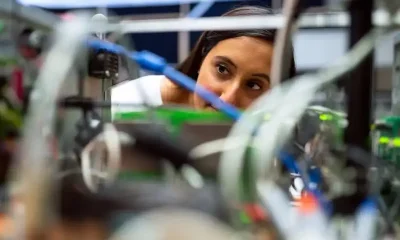Technology
How automotive exec Crystal Brown founded CircNova, an AI drug discovery biotech

Tiny Michigan biotech startup CircNova has raised a $3.3 million seed round for its technology that uses AI to target “circular RNA.” The development holds promise as a new method to quickly develop therapies for conditions that currently have no drug treatments.
The new funding is also a victory lap for co-founder and CEO Crystal Brown, who took an unconventional path to becoming a biotech founder.
RNA, or ribonucleic acid, is a key molecule that helps convert genetic information into proteins. Circular RNA is a relatively newly discovered class of such structures that form a circle rather than a strand. It regulates critical biological processes, and the hope is that therapies based on these molecules will be able to target complex health issues.
CircNova has developed a “proprietary AI engine that allows us to identify, design, and then produce novel, non-coding, circular RNAs,” Brown told TechCrunch.
It’s an AI engine similar to Google’s DeepMind AlphaFold, in that it also uses deep learning AI — not some kind of large language model — to generate and analyze new circular RNA for therapeutic use.
CircNova has not only its NovaEngine, which it says is the first in the world to be able to predict circular RNA structures, but it also has a wet lab. That means its AI engine produces the actual physical molecules themselves, which can then be validated and researched in collaboration with the University of Michigan, Brown said.
“We can reverse engineer. We can go from sequence to structure. We can go from structure to sequence when developing the molecule,” she says.
The goal is to “treat diseases we haven’t treated so far, things like ovarian cancer, triple-negative breast cancer, neurodegenerative diseases, rare genetic diseases,” she describes.
The tech is based on the work of CircNova co-founder Joe Deangelo, the startup’s chief scientific officer and previous CEO of biotech Neochromosome as well as the former CSO of Apex Bioscience. Investor William Grenawitzke is chief business officer and the startup’s third co-founder.
Lessons from a failed startup
Brown seems like an unlikely founder of such a company because until about seven years ago, her career had been in the automotive manufacturing industry.
She thought she was climbing the ladder to become a “C-suite automotive executive” when a friend of hers introduced her to a CEO running a life science startup. The startup CEO was looking for a business manager.
Curious, Brown offered to keep the books part-time, which evolved into her bringing business tactics from auto factories to help the startup, like overhauling their business contracts.
She peppered the team with questions about the science until some of her friends told her she should quit automotive and work full-time in biotech.
“I was like, no one’s gonna take me seriously. I’ve never studied biology. I studied poli sci and women’s studies,” she recalls.
But she made the leap anyway, taking a massive pay cut from her well-paying six-figure job to what amounted to intern-level pay. She learned about startups, raised money, and worked her way up to director of operations. The company went public, giving her a healthy enough payout to buy a house, she said.
Flushed with success, she launched a biotech startup of her own, a contract research lab.
She raised money, then made all the classic first-founder mistakes. “I hired people too quickly. I opened up my lab,” she said.
Two years in, her startup burned through its funds, and she knew she had to shutter it. It broke her heart and her bank account. She even lost her house, she recalled.
But she had gained a stellar reputation in Michigan’s tight-knit startup community and Brown recalls that VCs told her, “You’re a good founder anyway.” Several said they’d be open to funding her next idea.
Knowing she would soon be available for a new venture, Deangelo began sending her scientific material on circular RNA. He had an idea for how to use it with AI drug discovery.
“He started sending me, literally every morning at 5:30 … five to 10 articles,” she remembers. “I hadn’t even shut the other company down all the way.”
But she studied up and grew convinced this idea could work. They founded CircNova in May 2023.
“I went into it very cautiously, throwing just a few things at the wall. What can I do with the $15,000 grant to get it started?”
That first expenditure developed the startup’s first process and another $25,000 from a National Science Foundation grant led to the first patent application.
She began to split her time between Michigan and Boston, near her customers and wish-list customers like Moderna and Pfizer.
As for betting on Brown again, VCs like Nia Batts, a general partner at Union Heritage Ventures, had no problem with it.
“We are no stranger to the resilience that is needed when you engage in the journey of entrepreneurship,” Batts said, adding that she knew she wanted to back this new venture “the moment” she met Brown and heard about the idea.
This $3.3 million seed round was led by diversity-focused VC South Loop Ventures and includes investment from Dug Song, Union Heritage, Michigan Rise, Invest Detroit, Kalamazoo Forward Ventures, and SPARK Capital.
Technology
Did xAI lie about Grok 3’s benchmarks?

Debates over AI benchmarks — and how they’re reported by AI labs — are spilling out into public view.
This week, an OpenAI employee accused Elon Musk’s AI company, xAI, of publishing misleading benchmark results for its latest AI model, Grok 3. One of the co-founders of xAI, Igor Babushkin, insisted that the company was in the right.
The truth lies somewhere in between.
In a post on xAI’s blog, the company published a graph showing Grok 3’s performance on AIME 2025, a collection of challenging math questions from a recent invitational mathematics exam. Some experts have questioned AIME’s validity as an AI benchmark. Nevertheless, AIME 2025 and older versions of the test are commonly used to probe a model’s math ability.
xAI’s graph showed two variants of Grok 3, Grok 3 Reasoning Beta and Grok 3 mini Reasoning, beating OpenAI’s best-performing available model, o3-mini-high, on AIME 2025. But OpenAI employees on X were quick to point out that xAI’s graph didn’t include o3-mini-high’s AIME 2025 score at “cons@64.”
What is cons@64, you might ask? Well, it’s short for “consensus@64,” and it basically gives a model 64 tries to answer each problem in a benchmark and takes the answers generated most frequently as the final answers. As you can imagine, cons@64 tends to boost models’ benchmark scores quite a bit, and omitting it from a graph might make it appear as though one model surpasses another when in reality, that’s isn’t the case.
Grok 3 Reasoning Beta and Grok 3 mini Reasoning’s scores for AIME 2025 at “@1” — meaning the first score the models got on the benchmark — fall below o3-mini-high’s score. Grok 3 Reasoning Beta also trails ever-so-slightly behind OpenAI’s o1 model set to “medium” computing. Yet xAI is advertising Grok 3 as the “world’s smartest AI.”
Babushkin argued on X that OpenAI has published similarly misleading benchmark charts in the past — albeit charts comparing the performance of its own models. A more neutral party in the debate put together a more “accurate” graph showing nearly every model’s performance at cons@64:
Hilarious how some people see my plot as attack on OpenAI and others as attack on Grok while in reality it’s DeepSeek propaganda
(I actually believe Grok looks good there, and openAI’s TTC chicanery behind o3-mini-*high*-pass@”””1″”” deserves more scrutiny.) https://t.co/dJqlJpcJh8 pic.twitter.com/3WH8FOUfic— Teortaxes▶️ (DeepSeek 推特🐋铁粉 2023 – ∞) (@teortaxesTex) February 20, 2025
But as AI researcher Nathan Lambert pointed out in a post, perhaps the most important metric remains a mystery: the computational (and monetary) cost it took for each model to achieve its best score. That just goes to show how little most AI benchmarks communicate about models’ limitations — and their strengths.
Technology
The pain of discontinued items, and the thrill of finding them online

We’ve all been there. A favorite item is suddenly unavailable for purchase. Couldn’t the manufacturer have given you advance warning?
Whether owing to low sales, changing habits, production costs, or even because something is a little wrong with your favorite product (shh), discontinued items are part of life. In a weekend piece, the New York Times delves into the not-so-dark underbelly of online places where shoppers find these items, share tips and yes, find emotional support.
The story highlights a padded laptop bag made by Filson that a super fan now hunts “down everywhere” to snag as many as possible “before everyone figures out how great they are.” It points to Discontinued Beauty, a site whose offerings are old to visitors but new to the site. Among its latest products: an “essential protein restructurizer” by Redkin priced at an eye-popping $169.95. (The newest version of the product costs shoppers $32.)
Could it be dangerous to use these discontinued products? Who cares, suggests one creative director, who tells the Times about a lip pencil the beauty company NARS no longer sells and she has found elsewhere. “Now, do I know the proper way to store this for optimal conditions? No,” she says. “They’re under my sink.”
Technology
US AI Safety Institute could face big cuts

The National Institute of Standards and Technology could fire as many as 500 staffers, according to multiple reports — cuts that further threaten a fledgling AI safety organization.
Axios reported this week that the US AI Safety Institute (AISI) and Chips for America, both part of NIST, would be “gutted” by layoffs targeting probationary employees (who are typically in their first year or two on the job). And Bloomberg said some of those employees had already been given verbal notice of upcoming terminations.
Even before the latest layoff reports, AISI’s future was looking uncertain. The institute, which is supposed to study risks and develop standards around AI development, was created last year as part of then-President Joe Biden’s executive order on AI safety. President Donald Trump repealed that order on his first day back in office, and AISI’s director departed earlier in February.
Fortune spoke to a number of AI safety and policy organizations who all criticized the reported layoffs.
“These cuts, if confirmed, would severely impact the government’s capacity to research and address critical AI safety concerns at a time when such expertise is more vital than ever,” said Jason Green-Lowe, executive director of the Center for AI Policy.
-

 Technology8 months ago
Technology8 months agoTop 10 Technologically Advanced Countries and Their Products
-

 Technology7 months ago
Technology7 months agoWBTC (Wrapped Bitcoin)
-

 Technology8 months ago
Technology8 months agoDogecoin (DOGE) Cryptocurrency
-

 Technology9 months ago
Technology9 months agoTop 10 Trending Laptops Of 2024
-

 Technology7 months ago
Technology7 months agoEverything To Know About Litecoin As A Cryptocurrency
-

 Technology7 months ago
Technology7 months agoBKK:BCH Coin
-

 Technology8 months ago
Technology8 months agoCardano (ADA) Coin, Everything To Know
-

 Technology7 months ago
Technology7 months agoTron (TRX) Coin
